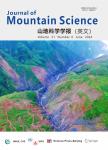East Asian summer monsoon changes in subtropical China since late Pleistocene:Evidence from the Ailuropoda-Stegodon fauna
East Asian summer monsoon changes in subtropical China since late Pleistocene: Evidence from the Ailuropoda-Stegodon fauna作者机构:School of Environmental and Chemical EngineeringFoshan UniversityFoshan 528225China State Key Laboratory of Nuclear Resources and EnvironmentEast China University of TechnologyNanchang 330013China School of GeographySouth China Normal UniversityGuangzhou 510631China School of Geography and TourismHuizhou UniversityHuizhou 516007China State Key Laboratory of Loess and Quaternary GeologyInstitute of Earth EnvironmentChinese Academy of SciencesXi'an 710061China
出 版 物:《Journal of Mountain Science》 (山地科学学报(英文))
年 卷 期:2022年第19卷第2期
页 面:418-432页
核心收录:
学科分类:0830[工学-环境科学与工程(可授工学、理学、农学学位)] 070903[理学-古生物学与地层学(含:古人类学)] 0709[理学-地质学] 07[理学]
基 金:financially supported by the National Natural Science Foundation of China(Grant No.41571007,41201006) the Strategic Priority Research Program of the Chinese Academy of Sciences(Category B,Grant No.XDB 26000000) the Open Fund Project of the State Key Laboratory of Nuclear Resources and Environment(Grant No.NRE1507)
主 题:Late Pleistocene to Holocene Subtropical China the Ailuropoda-Stegodon fauna Tropical animals migration East Asian summer monsoon changes The total solar radiation
摘 要:Previous studies on the amplitude of East Asian summer monsoon(EASM)changes mainly focused on northern China(represented by the Loess Plateau).However,a rare investigation centered on the subtropical zone of southern China,where the important route for EASM moved northward or southward,especially addressing a lack of the research on *** Ailuropoda-Stegodon fauna is a representative mammal fauna in southern China since the late *** indicates the southern mid-subtropicaltropical forest environment with tropical climate characteristics,and its southward or northward movements in the subtropical zone imply the changes of EASM *** on previous research,combined with the species characteristics and distribution range of the Ailuropoda-Stegodon fauna with tropical animals during the marine isotope stage 5(MIS5),MIS3,MIS2,and MIS1 Megathermal periods,this paper mainly investigates its evolution and the fluctuations of *** conclusions include:(1)The distribution geometric centers in the MIS5,MIS3,MIS2,and MIS1 Megathermal periods are(26°14′N,111°22′E),(24°35′N,107°30′E),(22°48′N,112°01′E),and(26°19′N,112°25′E),respectively.(2)Compared with the MIS5 period,the EASM of the MIS3 and MIS2 moved 180 km and 380 km southwards,and that of the MIS1 Megathermal period moved about 10 km *** EASM movement indicated by the fauna migration happened synchronous with the climate records of stalagmites in subtropical China,the sporopollen from eastern China,and oxygen isotopes from Sulu *** also correspond to the peaks and valleys of the total solar radiation at 35°N in the winter *** suggests that the migrations of the Ailuropoda-Stegodon fauna are consistent with the changes of the global climate,and the driving force is mainly from the changes of total solar radiation at 35°N in the winter half-year.



